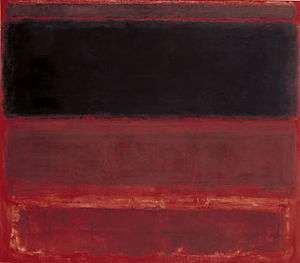Four Darks in Red
 | |
| Artist | Mark Rothko |
|---|---|
| Year | 1958 |
| Medium | Oil on Canvas |
| Dimensions | 259.1 cm × 294.6 cm (102.0 in × 116.0 in) |
| Location | Whitney Museum of American Art, New York |
Four Darks in Red shows Mark Rothko's often used axis of black, brown and red, which is in a number of his easel paintings and in the mural projects for the Seagram Building.
Rothko's work brought movement to the flat two-dimensional canvas. The canvas remains stationary but as the observer stares at the areas of color, they seem to move and vibrate. The perception of motion is an optical illusion because it is happening in the eyes and mind of the observer, not on the canvas itself. This motion imparts a pleasant feeling, much like light meditation might.
The red field against which the four dark forms float is first tinged with crimson, then with orange, then with brown. The lozenge shapes complement these shifts. The one closest to the lower edge of the canvas is a slightly blackened crimson. Moving vertically upwards, the next is more violet. The large area of black is first shaded with blue and then with green. And finally, squeezed in at the top of the canvas there is a thin strip of a rather nondescript, umberish brown which seems to be holding all the rest in place.
This is characteristic of Rothko's signature "multiform" style of blurred, lozenge shapes, moving horizontally across the surface of the canvas. Its meaning is difficult to comprehend, however it could be that, like Jackson Pollock, another Abstract Expressionist and contemporary of Rothko, the piece has no "meaning" in the normal sense of the word, but rather the painting is itself its own meaning. These paintings are not meant to be dissected and understood with the intellect, but focused on and joined with, enjoyed in a visual experience that can capture one's usually erratic attention and thereby uplift one's mood.